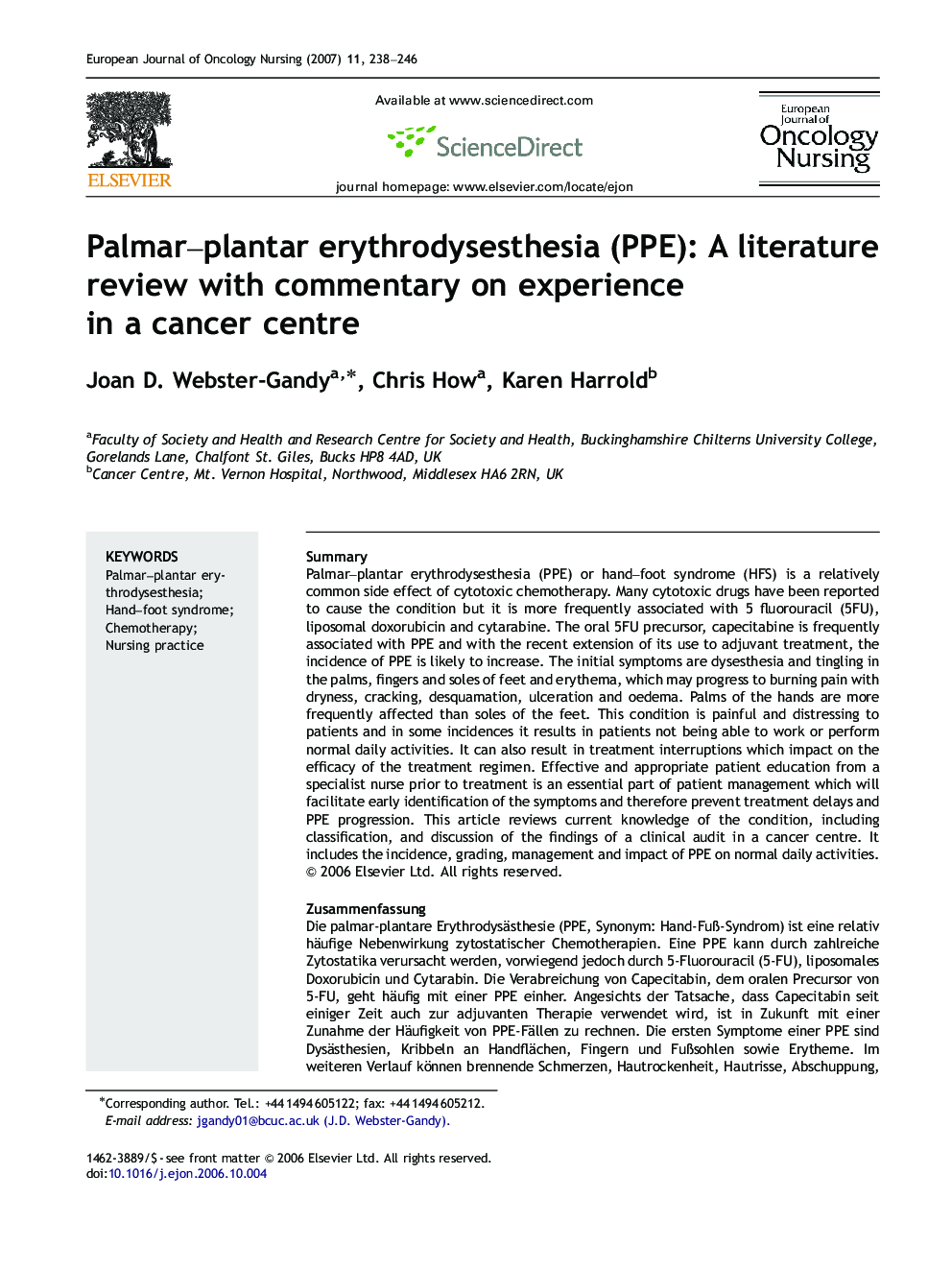| کد مقاله | کد نشریه | سال انتشار | مقاله انگلیسی | نسخه تمام متن |
|---|---|---|---|---|
| 2650114 | 1563864 | 2007 | 9 صفحه PDF | دانلود رایگان |

SummaryPalmar–plantar erythrodysesthesia (PPE) or hand–foot syndrome (HFS) is a relatively common side effect of cytotoxic chemotherapy. Many cytotoxic drugs have been reported to cause the condition but it is more frequently associated with 5 fluorouracil (5FU), liposomal doxorubicin and cytarabine. The oral 5FU precursor, capecitabine is frequently associated with PPE and with the recent extension of its use to adjuvant treatment, the incidence of PPE is likely to increase. The initial symptoms are dysesthesia and tingling in the palms, fingers and soles of feet and erythema, which may progress to burning pain with dryness, cracking, desquamation, ulceration and oedema. Palms of the hands are more frequently affected than soles of the feet. This condition is painful and distressing to patients and in some incidences it results in patients not being able to work or perform normal daily activities. It can also result in treatment interruptions which impact on the efficacy of the treatment regimen. Effective and appropriate patient education from a specialist nurse prior to treatment is an essential part of patient management which will facilitate early identification of the symptoms and therefore prevent treatment delays and PPE progression. This article reviews current knowledge of the condition, including classification, and discussion of the findings of a clinical audit in a cancer centre. It includes the incidence, grading, management and impact of PPE on normal daily activities.
ZusammenfassungDie palmar-plantare Erythrodysästhesie (PPE, Synonym: Hand-Fuß-Syndrom) ist eine relativ häufige Nebenwirkung zytostatischer Chemotherapien. Eine PPE kann durch zahlreiche Zytostatika verursacht werden, vorwiegend jedoch durch 5-Fluorouracil (5-FU), liposomales Doxorubicin und Cytarabin. Die Verabreichung von Capecitabin, dem oralen Precursor von 5-FU, geht häufig mit einer PPE einher. Angesichts der Tatsache, dass Capecitabin seit einiger Zeit auch zur adjuvanten Therapie verwendet wird, ist in Zukunft mit einer Zunahme der Häufigkeit von PPE-Fällen zu rechnen. Die ersten Symptome einer PPE sind Dysästhesien, Kribbeln an Handflächen, Fingern und Fußsohlen sowie Erytheme. Im weiteren Verlauf können brennende Schmerzen, Hautrockenheit, Hautrisse, Abschuppung, Ulzerationen und Ödeme auftreten. Die Handflächen sind häufiger betroffen als die Fußsohlen. Es handelt sich um ein schmerzhaftes und psychisch belastendes Krankheitsbild, das in manchen Fällen den Patienten daran hindert, seiner Arbeit oder seinen normalen Tagesaktivitäten nachzugehen. Eine weitere Folge können Unterbrechungen der Therapie und damit auch eine Beeinträchtigung der Wirksamkeit des Behandlungsregimes sein. Eine adäquate Schulung des Patienten vor Behandlungsbeginn durch eine spezialisierte Krankenpflegekraft ist von entscheidender Bedeutung, da sie die Chance einer Früherkennung der Symptome bietet, so dass das Risiko von Behandlungsverzögerungen und damit einer Progredienz der PPE verringert wird. Dieser Artikel enthält eine Review des derzeitigen Wissensstandes über die PPE einschließlich der Klassifikation dieses Krankheitsbildes sowie eine Diskussion der Ergebnisse eines klinischen Audits in einem Krebszentrum im Hinblick auf Inzidenz, Grading, Management und Auswirkungen der PPE auf die normalen Tagesaktivitäten.
Journal: European Journal of Oncology Nursing - Volume 11, Issue 3, July 2007, Pages 238–246